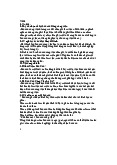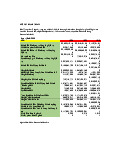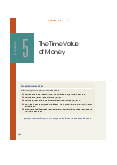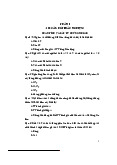



















Preview text:
Chapter 07 - Interest Rates and Bond Valuation
Chapter 07 Interest Rates and Bond Valuation Answer Key Multiple Choice Questions
1. Mary just purchased a bond which pays $60 a year in interest. What is this $60 called? A. coupon B. face value C. discount D. call premium E. yield Refer to section 7.1 AACSB: N/A Bloom's: Knowledge Difficulty: Basic Learning Objective: 7-1 Section: 7.1 Topic: Coupon
2. Bert owns a bond that will pay him $75 each year in interest plus a $1,000 principal
payment at maturity. What is the $1,000 called? A. coupon B. face value C. discount D. yield E. dirty price Refer to section 7.1 AACSB: N/A Bloom's: Knowledge Difficulty: Basic Learning Objective: 7-1 Section: 7.1 Topic: Face value 7-1
Chapter 07 - Interest Rates and Bond Valuation
3. A bond's coupon rate is equal to the annual interest divided by which one of the following? A. call price B. current price C. face value D. clean price E. dirty price Refer to section 7.1 AACSB: N/A Bloom's: Knowledge Difficulty: Basic Learning Objective: 7-1 Section: 7.1 Topic: Coupon rate
4. The specified date on which the principal amount of a bond is payable is referred to as which one of the following? A. coupon date B. yield date C. maturity D. dirty date E. clean date Refer to section 7.1 AACSB: N/A Bloom's: Knowledge Difficulty: Basic Learning Objective: 7-1 Section: 7.1 Topic: Maturity 7-2
Chapter 07 - Interest Rates and Bond Valuation
5. Currently, the bond market requires a return of 11.6 percent on the 10-year bonds issued by
Winston Industries. The 11.6 percent is referred to as which one of the following? A. coupon rate B. face rate C. call rate D. yield to maturity E. interest rate Refer to section 7.1 AACSB: N/A Bloom's: Knowledge Difficulty: Basic Learning Objective: 7-1 Section: 7.1 Topic: Yield to maturity
6. The current yield is defined as the annual interest on a bond divided by which one of the following? A. coupon B. face value C. market price D. call price E. dirty price Refer to section 7.1 AACSB: N/A Bloom's: Knowledge Difficulty: Basic Learning Objective: 7-1 Section: 7.1 Topic: Current yield 7-3
Chapter 07 - Interest Rates and Bond Valuation 7. An indenture is:
A. another name for a bond's coupon.
B. the written record of all the holders of a bond issue.
C. a bond that is past its maturity date but has yet to be repaid.
D. a bond that is secured by the inventory held by the bond's issuer.
E. the legal agreement between the bond issuer and the bondholders. Refer to section 7.2 AACSB: N/A Bloom's: Knowledge Difficulty: Basic Learning Objective: 7-1 Section: 7.2 Topic: Indenture
8. Atlas Entertainment has 15-year bonds outstanding. The interest payments on these bonds
are sent directly to each of the individual bondholders. These direct payments are a clear
indication that the bonds can accurately be defined as being issued: A. at par. B. in registered form. C. in street form. D. as debentures. E. as callable. Refer to section 7.2 AACSB: N/A Bloom's: Knowledge Difficulty: Basic Learning Objective: 7-1 Section: 7.2 Topic: Registered form 7-4
Chapter 07 - Interest Rates and Bond Valuation
9. A bond that is payable to whomever has physical possession of the bond is said to be in: A. new-issue condition. B. registered form. C. bearer form. D. debenture status. E. collateral status. Refer to section 7.2 AACSB: N/A Bloom's: Knowledge Difficulty: Basic Learning Objective: 7-1 Section: 7.2 Topic: Bearer form
10. The Leeward Company just issued 15-year, 8 percent, unsecured bonds at par. These
bonds fit the definition of which one of the following terms? A. note B. discounted C. zero-coupon D. callable E. debenture AACSB: N/A Bloom's: Knowledge Difficulty: Basic Learning Objective: 7-1 Section: 7.2 Topic: Debenture 7-5
Chapter 07 - Interest Rates and Bond Valuation
11. Which of the following defines a note? I. secured II. unsecured
III. maturity less than 10 years
IV. maturity in excess of 10 years A. III only B. I and III only C. I and IV only D. II and III only E. II and IV only AACSB: N/A Bloom's: Knowledge Difficulty: Basic Learning Objective: 7-1 Section: 7.2 Topic: Note
12. A sinking fund is managed by a trustee for which one of the following purposes? A. paying interest payments
B. early bond redemption
C. converting bonds into equity securities D. paying preferred dividends E. reducing coupon rates AACSB: N/A Bloom's: Knowledge Difficulty: Basic Learning Objective: 7-1 Section: 7.2 Topic: Sinking fund 7-6
Chapter 07 - Interest Rates and Bond Valuation
13. A bond that can be paid off early at the issuer's discretion is referred to as being which one of the following? A. zero coupon B. callable C. senior D. collateralized E. unsecured Refer to section 7.2 AACSB: N/A Bloom's: Knowledge Difficulty: Basic Learning Objective: 7-1 Section: 7.2 Topic: Call provision
14. A $1,000 face value bond can be redeemed early at the issuer's discretion for $1,030, plus
any accrued interest. The additional $30 is called which one of the following? A. dirty price B. redemption value C. call premium D. original-issue discount E. redemption discount Refer to section 7.2 AACSB: N/A Bloom's: Knowledge Difficulty: Basic Learning Objective: 7-1 Section: 7.2 Topic: Call premium 7-7
Chapter 07 - Interest Rates and Bond Valuation
15. A deferred call provision is which one of the following?
A. requirement that a bond issuer pay the current market price, plus accrued interest, should the firm decide to call a bond
B. ability of a bond issuer to delay repaying a bond until after the maturity date should the issuer so opt
C. prohibition placed on an issuer which prevents that issuer from ever redeeming bonds prior to maturity
D. prohibition which prevents bond issuers from redeeming callable bonds prior to a specified date
E. requirement that a bond issuer pay a call premium which is equal to or greater than one
year's coupon should that issuer decide to call a bond Refer to section 7.2 AACSB: N/A Bloom's: Knowledge Difficulty: Basic Learning Objective: 7-1 Section: 7.2 Topic: Deferred call provision
16. A call-protected bond is a bond that: A. is guaranteed to be called. B. can never be called. C. is currently being called. D. is callable at any time.
E. cannot be called during a certain period of time. Refer to section 7.2 AACSB: N/A Bloom's: Knowledge Difficulty: Basic Learning Objective: 7-1 Section: 7.2 Topic: Call-protected bond 7-8
Chapter 07 - Interest Rates and Bond Valuation
17. The items included in an indenture that limit certain actions of the issuer in order to
protect bondholder's interests are referred to as the: A. trustee relationships. B. bylaws. C. legal bounds. D. "plain vanilla" conditions.
E. protective covenants. Refer to section 7.2 AACSB: N/A Bloom's: Knowledge Difficulty: Basic Learning Objective: 7-1 Section: 7.2 Topic: Protective covenants
18. A bond that has only one payment, which occurs at maturity, defines which one of the following? A. debenture B. callable C. floating-rate D. junk E. zero coupon Refer to section 7.4 AACSB: N/A Bloom's: Knowledge Difficulty: Basic Learning Objective: 7-1 Section: 7.4 Topic: Zero-coupon bond 7-9
Chapter 07 - Interest Rates and Bond Valuation
19. Which one of the following is the price a dealer will pay to purchase a bond? A. call price B. asked price C. bid price D. bid-ask spread E. par value Refer to section 7.5 AACSB: N/A Bloom's: Knowledge Difficulty: Basic Learning Objective: 7-2 Section: 7.5 Topic: Bid price
20. You want to buy a bond from a dealer. Which one of the following prices will you pay? A. call price B. auction price C. bid price D. asked price E. bid-ask spread Refer to section 7.5 AACSB: N/A Bloom's: Knowledge Difficulty: Basic Learning Objective: 7-2 Section: 7.5 Topic: Asked price 7-10




